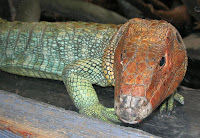
It is incredible because it has water, has a reasonable temperature, a protective atmosphere, and solid ground amongst other things.
A unique facet of Earth's supremacy in the known cosmos is it's biodiversity, or richness and abundance, of species. Maybe you take biodiversity for granted when you walk out your door to grab the morning paper and see a well-cut lawn, shady apple blossoms, and that darned neighborhood cat. Stop for a moment and really take in everything that you can see from your doorstep - wherever that may be.
Bacteria, viruses, fungi, and algae, and protozoans cover, penetrate, and consume everything in your sight. Your lawn and landscaping are probably comprised of over twenty plant species including grasses, trees, flowering plants, and leafy plants alone. Butterflies, ladybugs, houseflies, praying mantises, roaches, ants, bees, wasps, fleas, and ticks fly, jump, and scuttle about. Insects make up a huge portion of our Earth's biodiversity - part of the reason you never think twice before swatting that pesky mosquito. If you're looking to the sky, you might see 5-15 bird species, depending on how hard you're looking, and how far from the equator you are. If you're lucky, you can look in some bushes, under tree roots, or in your drainage ditch and find a couple of reptile or amphibian species. Come back at night (we're talking ~2-4am here) and you might catch a glimpse of some of the mammalian fauna living in very close proximity to you. Raccoons, foxes, coyotes, mice, voles, rabbits, cats (though not necessarily native), and rarely cougars or wolves might be digging through your trash or scurrying through your yard and marking their territory. Hey, they were probably there thousands of years before you were.
And last but not least, you. If you are reading this post properly, you are most likely a human, Homo sapiens. You may not care that much about that, but consider your evolutionary ancestors, primates in Africa and Southeastern Eurasia. Isn't it incredible how you live where you do, when your ancestors lived where they did? Without cars, airplanes, or trains, they populated all seven continents and took reign of terrestrial Earth as we know it.
If that wasn't a bit shocking, well, it shouldn't be. If you live in North America, you only experience a fraction of the total diversity of our planet. Additionally, if you followed through with the thought experiment I just laid out, you've not even stepped out of a human civilized habitat. Forests, swamps, grasslands, river systems, and the ocean contain more species than you could count in your lifetime (probably more than 10 of your lifetimes, if you tried from day one until you were on your death bed - obviously unreasonable).
So what? If you've been under the weather, maybe you haven't heard about the deforestation of our tropical forests, bleaching of coral reefs, and algal blooms killing millions of fish across our wonderful planet. In short, these are bad for the preservation of biodiversity. Reducing and fragmenting forests kills species (roads in the Amazon wreck major havoc on the ecosystem).
I've been reading E.O. Wilson's The Diversity of Life, and will comment on this further once finished. In the meantime, know that Wilson makes a claim in complete confidence that biodiversity is our planet's most valuable and most abused resourced. If I help one person think about that for a while, I've succeeded with this post.
 Subscribe
Subscribe




















.jpg)



























